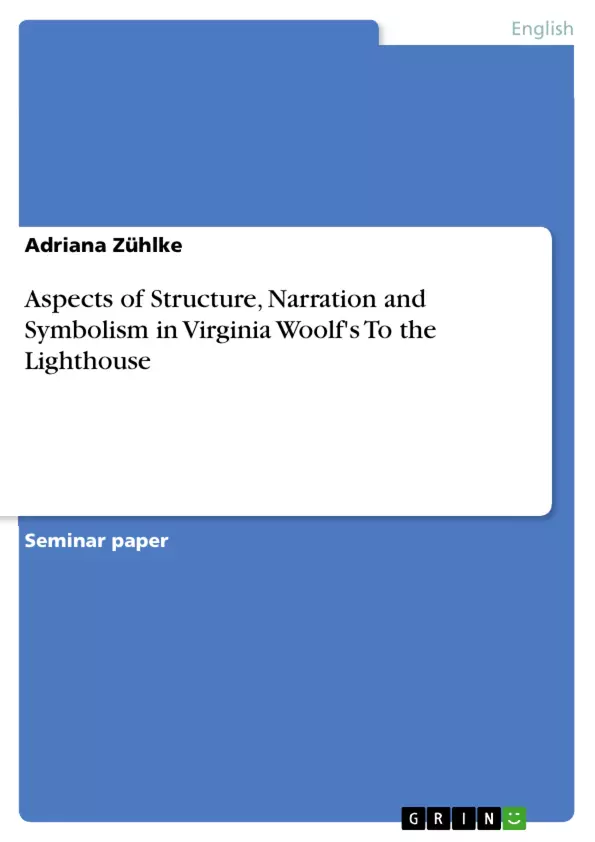Virginia Woolf′s novel To the lighthouse is seen as one of her most experimental works and some critics call it a "tour de force"; a masterpiece. In fact, it is a very special piece of fictional prose concerning narrative techniques, plot, symbolism or language, as this paper will show. Furthermore, it will be analyzed, which effects these means and techniques have on the reader and on the novel as a whole.
The first part of the analysis will concentrate on the questions how the novel is structured and why it is structured that way. Moreover, the problem of the plot will be discussed. In the second part called ′Narrative techniques′ it shall be focused on the different methods that are used to tell the novel, especially the stream of conscious- technique, because it offers particular possibilities, which have an effect on the characters′ portrayal and the novel′s style.
This paper′s last item examines symbolism and language and the connection between them. Especially the matter of symbolism is interesting, because it passes through the whole novel and has therefore certain importance and meaning, which is contemplated here. Virginia Woolf′s work differs from traditional novels in many points. Some of these points I chose as topics for my term paper, because I would like to show that they are part of the novel′s uniqueness.
Table of Contents
- 1.0 Introduction
- 2.0 Main Part: Aspects of Structure,
Narration and Symbolism in
Virginia Woolf's To the Lighthouse
- 2.1 Structure and Plot
- 2.2 Narration and Narrative Techniques
- 2.3 Language and Symbolism
- 3.0 Bibliography
- 3.1 References
Objectives and Key Themes
This paper aims to analyze the structural, narrative, and symbolic elements of Virginia Woolf's novel *To the Lighthouse*, highlighting the unique qualities that distinguish it from traditional novels. The paper examines how these elements contribute to the novel's overall effect on the reader.
- The unconventional structure of *To the Lighthouse* and its impact on the narrative.
- The significance of the novel's narrative techniques, including the use of stream of consciousness.
- The exploration of symbolism and language in the novel and their role in conveying meaning.
- The artistic nature of *To the Lighthouse* and its similarity to a work of visual art.
- The development of characters throughout the novel, particularly their journeys towards higher perception and consciousness.
Chapter Summaries
The first section, "The Window," introduces the reader to the characters and their relationships. The main focus is on Mrs. Ramsay, who acts as the center of the household and a mediator among the characters. This section covers a single day but provides a detailed picture of the family's dynamic.
The second section, "Time passes," covers a period of ten years and explores the changes that have occurred within the family. It emphasizes the transition from Mrs. Ramsay's dominance to Mr. Ramsay's role as the main parent.
The third section, "The Lighthouse," focuses on the journey to the lighthouse, which was promised to James at the beginning of the novel. This act symbolizes the completion of a journey both physically and metaphorically. The section also parallels Lily Briscoe's painting, which she is finally able to finish.
Keywords
The main keywords of this paper are: *To the Lighthouse*, Virginia Woolf, structure, plot, narrative techniques, stream of consciousness, symbolism, language, artistic composition, character development, and perception.
- Quote paper
- Adriana Zühlke (Author), 2002, Aspects of Structure, Narration and Symbolism in Virginia Woolf's To the Lighthouse, Munich, GRIN Verlag, https://www.grin.com/document/8966



